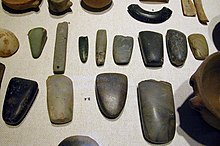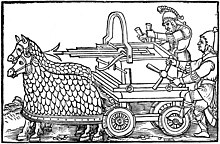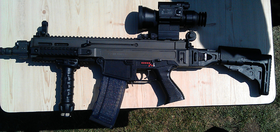A weapon, arm or armament is any implement or
device that can be used with intent to inflict damage or harm. Weapons
are used to increase the efficacy and efficiency of activities such as hunting, crime, law enforcement, self-defense, and warfare.
In broader context, weapons may be construed to include anything used
to gain a tactical, strategic, material or mental advantage over an
adversary or enemy target.
While ordinary objects – sticks, rocks, bottles, chairs, vehicles
– can be used as weapons, many are expressly designed for the purpose;
these range from simple implements such as clubs, axes and swords, to complicated modern firearms, tanks, intercontinental ballistic missiles, biological weapons, and cyberweapons. Something that has been re-purposed, converted, or enhanced to become a weapon of war is termed weaponized, such as a weaponized virus or weaponized laser.
History
Prehistoric
The use of objects as weapons has been observed among chimpanzees, leading to speculation that early hominids used weapons as early as five million years ago.
However, this can not be confirmed using physical evidence because
wooden clubs, spears, and unshaped stones would have left an ambiguous
record. The earliest unambiguous weapons to be found are the Schöningen spears, eight wooden throwing spears dating back more than 300,000 years.
At the site of Nataruk in Turkana, Kenya, numerous human skeletons
dating to 10,000 years ago may present evidence of traumatic injuries to
the head, neck, ribs, knees and hands, including obsidian
projectiles embedded in the bones that might have been caused from
arrows and clubs during conflict between two hunter-gatherer groups. But the evidence interpretation of warfare at Nataruk has been challenged.
Ancient history
A four-wheeled ballista drawn by armored cataphract horses, c. 400.
The earliest ancient weapons were evolutionary improvements of late neolithic implements, but significant improvements in materials and crafting techniques led to a series of revolutions in military technology.
The development of metal tools began with copper during the Copper Age (about 3,300 BC) and was followed by the Bronze Age, leading to the creation of the Bronze Age sword and similar weapons.
During the Bronze Age, the first defensive structures and fortifications appeared as well, indicating an increased need for security. Weapons designed to breach fortifications followed soon after, such as the battering ram, which was in use by 2500 BC.
The development of iron-working around 1300 BC in Greece had an important impact on the development of ancient weapons. It was not the introduction of early Iron Age swords, however, as they were not superior to their bronze predecessors,
but rather the domestication of the horse and widespread use of spoked wheels by c. 2000 BC. This led to the creation of the light, horse-drawn chariot, whose improved mobility proved important during this era. Spoke-wheeled chariot usage peaked around 1300 BC and then declined, ceasing to be militarily relevant by the 4th century BC.
Cavalry developed once horses were bred to support the weight of a human. The horse extended the range and increased the speed of attacks.
In addition to land based weaponry, warships, such as the trireme, were in use by the 7th century BC.
Post-classical history
Medieval Indian weapons
Ancient Chinese cannon displayed in the Tower of London.
European warfare during the Post-classical history was dominated by elite groups of knights supported by massed infantry (both in combat and ranged roles). They were involved in mobile combat and sieges which involved various siege weapons and tactics. Knights on horseback developed tactics for charging with lances providing an impact on the enemy formations and then drawing more practical weapons (such as swords)
once they entered into the melee. By contrast, infantry, in the age
before structured formations, relied on cheap, sturdy weapons such as spears and billhooks in close combat and bows from a distance. As armies became more professional, their equipment was standardized and infantry transitioned to pikes. Pikes are normally seven to eight feet in length, and used in conjunction with smaller side-arms (short sword).
In Eastern and Middle Eastern warfare, similar tactics were developed independent of European influences.
The introduction of gunpowder from the Asia at the end of this period revolutionized warfare. Formations of musketeers, protected by pikemen came to dominate open battles, and the cannon replaced the trebuchet as the dominant siege weapon.
Modern history
Early modern
The European Renaissance marked the beginning of the implementation of firearms in western warfare. Guns and rockets were introduced to the battlefield.
Firearms are qualitatively different from earlier weapons because they release energy from combustible propellants such as gunpowder,
rather than from a counter-weight or spring. This energy is released
very rapidly and can be replicated without much effort by the user.
Therefore even early firearms such as the arquebus were much more powerful
than human-powered weapons. Firearms became increasingly important and
effective during the 16th century to 19th century, with progressive
improvements in ignition mechanisms followed by revolutionary changes in ammunition handling and propellant. During the U.S. Civil War new applications of firearms including the machine gun and ironclad warship emerged that would still be recognizable and useful military weapons today, particularly in limited conflicts. In the 19th century warship propulsion changed from sail power to fossil fuel-powered steam engines.
Since the mid-18th century North American French-Indian war through
the beginning of the 20th century, human-powered weapons were reduced
from the primary weaponry of the battlefield yielding to gunpowder-based
weaponry. Sometimes referred to as the "Age of Rifles",
this period was characterized by the development of firearms for
infantry and cannons for support, as well as the beginnings of
mechanized weapons such as the machine gun.
Of particular note, Howitzers were able to destroy masonry fortresses and other fortifications, and this single invention caused a Revolution in Military Affairs (RMA), establishing tactics and doctrine that are still in use today.
Industrial age
Assault rifle CZ-805 BREN (produced in Czech Republic).
An important feature of industrial age warfare was technological escalation – innovations were rapidly matched through replication or countered by another innovation. The technological escalation during World War I (WW I) was profound, including the wide introduction of aircraft into warfare, and naval warfare with the introduction of aircraft carriers.
World War I
World War I marked the entry of fully industrialized warfare as well as weapons of mass destruction (e.g., chemical and biological weapons),
and new weapons were developed quickly to meet wartime needs. Above
all, it promised to the military commanders the independence from the
horse and the resurgence in maneuver warfare through extensive use of motor vehicles. The changes that these military technologies underwent before and during the Second World War were evolutionary, but defined the development for the rest of the century.
Interwar
This period of innovation in weapon design continued in the inter-war period (between WW I and WW II) with continuous evolution of weapon systems by all major industrial powers. The major armament firms were the Schneider-Creusot (based in France), the Škoda Works (Czechoslovakia), and Vickers
(Great Britain). The 1920s were committed to disarmament and outlawing
of war and poison gas, but rearmament picked up rapidly in the 1930s.
The munitions makers responded nimbly to the rapidly shifting strategic
and economic landscape. The main purchasers of munitions from the big
three companies were Romania, Yugoslavia, Greece, and Turkey-- and, to a
lesser extent, in Poland, Finland, the Baltic States, and the Soviet
Union,
Criminalizing poison gas
Realistic
critics understood that war could not really be outlawed, but its worst
excesses might be banned. Poison gas became the focus of a worldwide
crusade in the 1920s. Poison gas did not win battles, and the generals
did not want it. The soldiers hated it far more intensely than bullets
or explosive shells. By 1918, chemical shells made up 35 per cent of
French ammunition supplies, 25 per cent of British, and 20 per cent of
the American stock. The “Protocol for the Prohibition of the Use in War
of Asphyxiating, Poisonous, or Other Gases and of Bacteriological
Methods of Warfare” ["Geneva Protocol"] was issued in 1925, and was
accepted as policy by all major countries. In 1937 poison gas was
manufactured in large quantities, but not used except against nations
that lacked modern weapons or gas masks.
World War II
Many
modern military weapons, particularly ground-based ones, are relatively
minor improvements of weapon systems developed during World War II.
World War II
however, perhaps marked the most frantic period of weapons development
in the history of humanity. Massive numbers of new designs and concepts
were fielded, and all existing technologies were improved between 1939
and 1945. The most powerful weapon invented during this period was the atomic bomb,
however many other weapons influenced the world, such as jet planes and
radar, but were overshadowed by the visibility of nuclear weapons And
long-range rockets.
Nuclear weapons
Since the realization of mutually assured destruction (MAD), the nuclear option of all-out war is no longer considered a survivable scenario. During the Cold War in the years following World War II, both the United States and the Soviet Union engaged in a nuclear arms race.
Each country and their allies continually attempted to out-develop each
other in the field of nuclear armaments. Once the joint technological
capabilities reached the point of being able to ensure the destruction
of the Earth x100 fold, then a new tactic had to be developed. With
this realization, armaments development funding shifted back to
primarily sponsoring the development of conventional arms technologies
for support of limited wars rather than total war.
Post Cold War
During
the late 2010s, tensions between the West and the East escalate as
nuclear-based issues arise. Such event has been since dubbed as Cold War II.
Types
By user
- Personal weapons (or small arms) – designed to be used by a single person.
- Light weapons – 'man-portable' weapons that may require a small team to operate.
- Heavy weapons – artillery and similar weapons larger than light weapons.
- Hunting weapon – used by hunters for sport or getting food.
- Crew served weapons – larger than personal weapons, requiring two or more people to operate correctly.
- Fortification weapons – mounted in a permanent installation, or used primarily within a fortification.
- Mountain weapons – for use by mountain forces or those operating in difficult terrain.
- Vehicle weapons – to be mounted on any type of combat vehicle.
- Railway weapons – designed to be mounted on railway cars, including armored trains.
- Aircraft weapons – carried on and used by some type of aircraft, helicopter, or other aerial vehicle.
- Naval weapons – mounted on ships and submarines.
- Space weapons – are designed to be used in or launched from space.
- Autonomous weapons – are capable of accomplishing a mission with limited or no human intervention.
By function
- Antimatter weapons (theoretical) would combine matter and antimatter to cause a powerful explosion.
- Archery weapons operate by using a tensioned string and bent solid to launch a projectile.
- Artillery are firearms capable of launching heavy projectiles over long distances.
- Biological weapons spread biological agents, causing disease or infection.
- Chemical weapons, poisoning and causing reactions.
- Energy weapons rely on concentrating forms of energy to attack, such as lasers or sonic attack.
- Explosive weapons use a physical explosion to create blast concussion or spread shrapnel.
- Firearms use a chemical charge to launch projectiles.
- Improvised weapons are common objects, reused as weapons, such as crowbars and kitchen knives.
- Incendiary weapons cause damage by fire.
- Non-lethal weapons are designed to subdue without killing.
- Magnetic weapons use magnetic fields to propel projectiles, or to focus particle beams.
- Melee weapons operate as physical extensions of the user's body and directly impact a close target.
- Blade weapons, designed to pierce through flesh and cause bleeding.
- Blunt instruments, designed to break bones, concuss or produce crush injuries.
- Missiles are rockets which are guided to their target after launch. (Also a general term for projectile weapons).
- Loitering munitions, designed to loiter over a battlefield, striking once a target is located.
- Nuclear weapons use radioactive materials to create nuclear fission and/or nuclear fusion detonations.
- Primitive weapons make little or no use of technological or industrial elements.
- Ranged weapons (unlike mêlée weapons), target a distant object or person.
- Rockets use chemical propellant to accelerate a projectile
- Suicide weapons exploit the willingness of their operator not surviving the attack.
- Refugees as weapons a mass exodus of refugees from a state to a hostile state as a "weapon" against an enemy.
By target
- Anti-aircraft weapons target missiles and aerial vehicles in flight.
- Anti-fortification weapons are designed to target enemy installations.
- Anti-personnel weapons are designed to attack people, either individually or in numbers.
- Anti-radiation weapons target sources of electronic radiation, particularly radar emitters.
- Anti-satellite weapons target orbiting satellites.
- Anti-ship weapons target ships and vessels on water.
- Anti-submarine weapons target submarines and other underwater targets.
- Anti-tank weapons are designed to defeat armored targets.
- Area denial weapons target territory, making it unsafe or unsuitable for enemy use or travel.
- Hunting weapons are weapons used to hunt game animals.
- Infantry support weapons are designed to attack various threats to infantry units.
Manufacture of weapons
The arms industry is a global industry that involves the sales and manufacture of weaponry. It consists of a commercial industry involved in the research and development, engineering, production, and servicing of military material, equipment, and facilities. Many industrialized countries
have a domestic arms-industry to supply their own military forces - and
some also have a substantial trade in weapons for use by its citizens,
for self-defence, hunting or sporting purposes.
Contracts to supply a given country's military are awarded by
governments, making arms contracts of substantial political importance.
The link between politics and the arms trade can result in the
development a "military-industrial complex", where the armed forces, commerce, and politics become closely linked.
Legislation
The production, possession, trade and use of many weapons are controlled. This may be at a local or central government level, or international treaty. Examples of such controls include:
Gun laws
All countries have laws and policies regulating aspects such as the
manufacture, sale, transfer, possession, modification and use of small
arms by civilians.
Countries which regulate access to firearms will typically
restrict access to certain categories of firearms and then restrict the
categories of persons who may be granted a license for access to such
firearms. There may be separate licenses for hunting, sport shooting
(a.k.a. target shooting), self-defense, collecting, and concealed carry,
with different sets of requirements, permissions, and responsibilities.
Arms control laws
International treaties and agreements place restrictions upon the
development, production, stockpiling, proliferation and usage of weapons
from small arms and heavy weapons to weapons of mass destruction.
Arms control is typically exercised through the use of diplomacy which
seeks to impose such limitations upon consenting participants, although
it may also comprise efforts by a nation or group of nations to enforce
limitations upon a non-consenting country.
Arms trafficking laws
Arms trafficking is the trafficking of contraband weapons and ammunition. What constitutes legal trade in firearms varies widely, depending on local and national laws.
Lifecycle problems
There
are a number of issue around the potential ongoing risks from deployed
weapons, the safe storage of weapons, and their eventual disposal when
no longer effective or safe.
- Ocean dumping of unused weapons and bombs, including ordinary bombs, UXO, landmines and chemical weapons has been common practice by many nations, and often caused hazards.
- Unexploded ordnance (UXO) are bombs, land mines and naval mines and similar that did not explode when they were employed and still pose a risk for many years or decades.
- Demining or mine clearance from areas of past conflict is a difficult process, but every year, landmines kill 15,000 to 20,000 people and severely maim countless more.
- Nuclear terrorism was a serious concern after the fall of the Soviet Union, with the prospect of "loose nukes" being available. While this risk may have receded, similar situation may arise in the future.
In science fiction
Strange and exotic weapons are a recurring feature or theme in science fiction. In some cases, weapons first introduced in science fiction have now been made a reality. Other science fiction weapons remain purely fictional, and are often beyond the realms of known physical possibility.
At its most prosaic, science fiction features an endless variety of sidearms, mostly variations on real weapons such as guns and swords. Among the best-known of these are the phaser used in the Star Trek television series, films and novels and the lightsaber and blaster featured in the Star Wars movies, comics, novels and TV series.
In addition to adding action and entertainment value, weaponry in
science fiction sometimes become themes when they touch on deeper
concerns, often motivated by contemporary issues. One example is science
fiction that deals with weapons of mass destruction.







